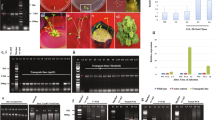Abstract
Transgenic radish (Raphanus sativus L. longipinnatus Bailey) plants were produced from the progeny of plants which were dipped into a suspension of Agrobacterium carrying both the β-glucuronidase (gusA) gene and a gene for resistance to the herbicide Basta (bar) between T-DNA border sequences. The importance of development of the floral-dipped plant and presence of surfactant in the inoculation medium were evaluated in terms of transgenic plant production. Plants dipped at the primary bolt stage of growth, into a suspension of Agrobacterium containing 0.05% (v/v) Silwet L-77 resulted in optimum transformation efficiency, with 1.4% from 1110 seeds. The presence of Pluronic F-68 or Tween 20 in the inoculation medium was beneficial towards transgenic plant output compared to treatments without surfactant. Putative transformed T1 plants were efficiently selected by spraying with 0.03% (v/v) Basta and all herbicide-resistant plants tested positive for GUS activity when analysed both histochemically and fluorometrically. Southern analysis revealed that both the gusA and bar genes integrated into the genome of transformed plants and segregated as dominant Mendelian traits. These results demonstrate that radish can be genetically modified for the improvement of this important vegetable crop.
Similar content being viewed by others
References
Akama K, Puchata H and Hohn B (1995) Efficient Agrobacteriummediated transformation of Arabidopsis thaliana using the bar gene as selectable marker. Plant Cell Rep. 14: 450–454.
An G (1987) Binary Ti vectors for plant transformation and promoter analysis. Meth. Enzymol. 153: 292–305.
Bechtold N, Ellis J and Pelletier G (1993) In plant Agrobacteriummediated gene transfer by infiltration of adult Arabidopsis thaliana plants. C. R. Acad. Sci. Paris, Life Sci. 316: 1194–1199.
Clough SJ and Bent AF (1998) Floral dip: a simplified method for Agrobacterium-mediated transformation of Arabidopsis thaliana. Plant J. 16: 735–743.
Curtis IS, Power JB, Blackhall NW, de Laat AMM and Davey MR (1994) Genotype-independent transformation of lettuce using Agrobacterium tumefaciens. J. Exp. Bot. 45: 1441–1449.
Curtis IS, Power JB, Hedden P, Phillips A, Lowe KC, Ward DA and Davey MR (2000) Transformation and characterization of transgenic plants of Solanum dulcamara L.–incidence of transgene silencing. Ann. Bot. 86: 63–71.
Dellaporta SL, Wood J and Hicks IB (1983) A plant DNA minipreparation: version II. Plant Mol. Biol. Rep. 1: 19–21.
Desfeux C, Clough SJ and Bent AF (2000) Female reproductive tissues are the primary target of Agrobacterium-mediated transformation by the Arabidopsis floral-dip method. Plant Physiol. 123: 895–904.
D'Halluin K, De Block M, Deneoke J, Janssens J, Leemans J, Reynaerts A and Botterman J (1992) The bar gene as selectable and screenable marker in plant engineering. Meth. Enzymol. 216: 415–426.
Feldmann KA and Marks MD (1987) Agrobacterium-mediated transformation of germinating seeds of Arabidopsis thaliana: a non-tissue culture approach. Mol. Gen. Genet. 208: 1–9.
Gartland KMA, Phillips JP, Vitha S and Benes K (1995) Fluorometric GUS analysis for transformed plant material. In Gartland K and Davey M (eds), Agrobacterium Protocols, Methods in Molecular Biology. 44: 195–199. Totowa, New Jersey, USA: Humana Press.
Kar S, Johnson TM, Nayak P and Sen SK (1996) Efficient transgenic plant regeneration through Agrobacterium-mediated transformation of chickpea (Cicer arietinum L.) Plant Cell Rep. 16: 32–37.
Keller G, Spatola L, McCabe D, Martinell B, Swain W and John ME (1997) Transgenic cotton resistant to herbicide bialaphos. Transgenic Res. 6: 385–392.
Khatun A, Davey MR, Power JB and Lowe KC (1993) Stimulation of shoot regeneration from jute cotyledons cultured with nonionic surfactants and relationship to physio-chemical properties. Plant Cell Rep. 13: 49–53.
Lazo GR, Stein PA and Ludwig RA (1991) A DNA transformationcompetent Arabidopsis genomic library in Agrobacterium. Bio/Technol. 9: 963–967.
Lowe KC, Davey MR, Power JB, Mulligan BJ (1993) Surfactant supplements in plant culture systems. Agro-food Ind. Hi-Tech 4: 9–13.
Mantis NJ and Winans SC (1992) The Agrobacterium tumefaciens vir gene transcriptional activator virG is transcriptionally induced by acid pH and other stresss stimuli. J. Bacteriol. 174: 1189–1196.
Matsubara S and Hegazi HH (1990) Plant regeneration from hypocotyl callus of radish. HortSci. 25: 1286–1288.
Mohapatra U, McCabe MS, Power JB, Schepers F, Van der Arend A and Davey MR (1999) Expression of the bar gene confers herbicide resistance in transgenic lettuce. Transgenic Res. 8: 33–44.
Pua EC, Sim GE, Chi GL and Kong LF (1996) Synergistic effect of ethylene inhibitors and putrescine on shoot regeneration from hypocotyl explants of Chinese radish (Raphanus sativus L. var. longipinnatus Bailey) in vitro. Plant Cell Rep. 15: 685–690.
Qing CM, Fan L, Lei Y, Bouchez D, Tourneur C, Yan L and Robaglia C (2000) Transformation of Pakchoi (Brassica rapa L. ssp. chinensis) by Agrobacterium infiltration. Mol. Breed. 6: 67–72.
Thompson CJ, Rao Movva N, Tizard R, Crameri R, Davies JE, Lauwereys M and Botterman J (1987) Characterisation of the herbicide-resistance gene bar from Streptomyces hygroscopicus. EMBO J. 6: 2519–2523.
Trieu AT, Burleigh SH, Kardailsky IV, Maldonado-Mendoza IE, Versaw WK, Blaylock LA et al. (2000) Transformation of Medicago truncatula via infiltration of seedlings or flowering plants with Agrobacterium. Plant J. 22: 531–541.
Ye GN, Stone D, Pang SZ, Creely W, Gonzalez K and Hinchee M (1999) Arabidopsis ovule is the target for Agrobacterium in planta vacuum infiltration transformation. Plant J. 19: 249–257.
Author information
Authors and Affiliations
Rights and permissions
About this article
Cite this article
Curtis, I.S., Nam, H.G. Transgenic radish (Raphanus sativus L. longipinnatus Bailey) by floral-dip method – plant development and surfactant are important in optimizing transformation efficiency. Transgenic Res 10, 363–371 (2001). https://doi.org/10.1023/A:1016600517293
Issue Date:
DOI: https://doi.org/10.1023/A:1016600517293




